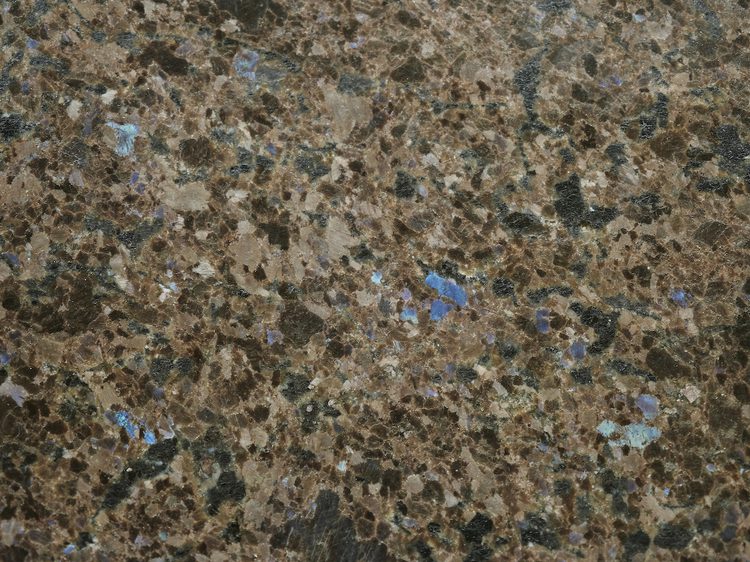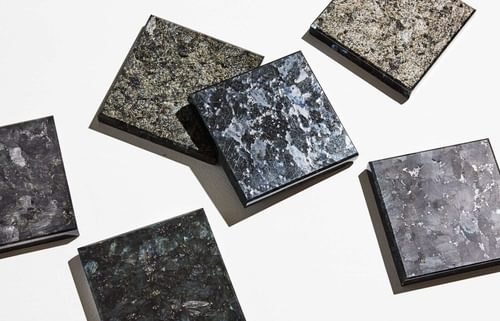
Anorthosite is a rare igneous rock, prized for its warm tones, iridescence, and exceptional durability.

Among Norway’s most unique natural stones is Anorthosite – a rock with spectacular play of colors and deep roots in Norwegian geology. Anorthosite is quarried along the coast of Rogaland in Norway, and is characterized by blue, green, and golden reflections – a durable and beautiful stone that combines nature’s own art with timeless design.

Anorthosite is a rare igneous rock, prized for its warm tones, iridescence, and exceptional durability.
Anorthosite is a unique and exclusive intrusive igneous rock composed almost entirely of plagioclase – a type of calcium-sodium feldspar. When the ratio between calcium and sodium is ‘just right,’ the crystals display an intense and fascinating play of colors in blue, green, and gold. This optical phenomenon, known as labradorescence, is caused by the way light is refracted and reflected within microscopic lamellae inside the crystals.
The result is a vibrant, metallic sheen that makes the stone distinctive and sought after internationally.

Map of the Egersund–Ogna Anorthosite, potentially important occurrences (yellow) and quarry (square). Illustration by Anette Granseth, Geological Survey of Norway (NGU), 2025.
Anorthosite in Norway
In Norway, Anorthosite is found primarily within the so-called Egersund Intrusion – a geological formation stretching along the coast between Flekkefjord and Ogna in Rogaland. This region is home to some of the world’s most beautiful and valuable deposits, celebrated for their aesthetic qualities and exceptional technical strength.
Dense, durable, and highly weather-resistant, anorthosite from the Egersund Intrusion is ideal for both exterior façades and interior applications. With its dramatic play of colors and robust character, it combines the beauty of nature with enduring performance.
A landscape shaped by stone
The landscape along Norway’s southwest coast is both striking and austere – defined by low, rounded hills, exposed rock faces, and nutrient-poor soils. This distinctive terrain is a direct product of the underlying bedrock: an expansive body of anorthosite and closely related intrusive rocks.
In 1897, the geologist Carl Fredrik Kolderup captured both the grandeur and the desolation of the region, while also hinting at its industrial potential:
“It is these labrador stones, with their bare domes upon which not a trace of vegetation can be found, that in all their bleakness make such an impressive impact on the traveler, leaving him with an impression of desolation and barrenness that is not soon forgotten.”
Kolderup was also the first to highlight the potential value of these rocks to Norway’s stone industry – a prediction that would be proven correct, though not until nearly a century later.

Quarry in Sirevåg where Lundhs Antique® is extracted.

Quality control in the quarry: our experienced staff use their trained eye to ensure that each block meets Lundhs’ high standards.

Massive Anorthosite blocks ready for transport to the port, before being shipped to projects around the world.

Nature’s own artwork: unique structures captured in raw Anorthosite, formed nearly one billion years ago.
A Stone with Iridescence
Geologically, Anorthosite is an igneous rock formed nearly one billion years ago deep within the Earth’s crust. It is composed primarily of plagioclase feldspar, though its composition can vary. When the calcium content in the crystals falls between 47 and 58 percent, a spectacular play of colors can occur – often in shades of blue, green, or gold – depending on the precise chemical balance.
This visual effect is the result of so-called perthitic lamellae, where light is refracted within the crystal’s microstructure. The most beautiful varieties are found in limited pockets within the Egersund–Ogna massif, and it is precisely these zones that provide the basis for today’s natural stone production.

Geologically speaking, Anorthosite is an igneous rock, formed nearly one billion years ago deep within the Earth’s crust.

Each slab is unique, with its own play of colors, pattern, and story.
A Piece of Geology – and History
Although the coastal Anorthosites were described as early as the 19th century – including by Jens Esmark in 1823 – it took a long time before the stone was commercially exploited. Initially, it was used locally for foundations, stairways, bridges, and gravestones, without particular attention to its characteristic play of colors.
It was not until the 1990s, through collaboration between local municipalities and the Geological Survey of Norway (NGU), that the stone’s full potential was brought to light. In 1996, North Sea Stone Industry opened the first modern quarry near Sirevåg, and a few years later, Larvik Granite established operations in the Hellvik area.
Anorthosite from Lundhs
Today, Lundhs owns and operates quarries containing some of the finest Anorthosite deposits in Norway. Under the brand name Lundhs Antique®, we offer 100% natural stone, extracted directly from the Norwegian bedrock. Each block is processed with respect for both the environment and the local community, combining natural beauty with exceptional technical performance.
Every slab is unique – with its own colors, patterns, and story – yet all share the same strength, durability, and natural elegance that has been hidden in the mountains for nearly a billion years. Lundhs Antique® is used in everything from exclusive kitchen countertops to prestigious international façade projects, and Norwegian anorthosite is now recognized and valued worldwide.
When you choose Anorthosite from Lundhs, you are not only selecting a beautiful natural stone – you are also bringing home a material that carries the story of Norwegian geology and modern craftsmanship.
This text is based on professional notes and outreach material prepared by geologist Magne Martinsen. His work in mapping, documenting, and communicating the Anorthosite deposits of the Egersund Intrusion forms the foundation for the geological, historical, and industrial insights presented here.
Other sources:
Gautneb, H., & Tveten, E. (1994). Bedrock mapping of the upper part of the Bjerkreim–Sokndal intrusion, Rogaland, with emphasis on anorthositic rocks (NGU Report 94.029). Geological Survey of Norway. https://static.ngu.no/upload/Publikasjoner/Rapporter/1994/94_029.pdf
Granseth, A. (2025). Map of anorthosite deposits [Map]. Geological Survey of Norway (NGU).
Kolderup, C. F. (1897). On the occurrence of anorthositic rocks in Norway. Bergens Museums årbog, 1897, 146. Bergen Museum. https://marcus.uib.no/instance/page/ubb-bgm-bok-1897_p146.html


Welcome to Lundhs.
Our site is also available
in Norwegian